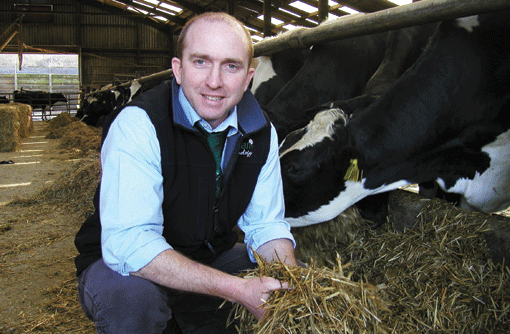Assess your ration presentation

With feed prices at an all time high, dairy producers could see even greater benefits from boosting feed conversion efficiency (FCE) this year, according to Keenan nutritionist Mark Voss.
He says that farmers fall into two camps when it comes to FCE and should consider the following points to boost returns.
1) Intakes are ok, but output is disappointing
Two- thirds of farmers are in this category; the key is to do an MOT on the ration and assess why your ration is not working for you.
“This issue is commonly presented as a looseness in the dung, with feed passing whole or not fully digested. This was a particular problem in the south last winter, with many farmers having difficulties balancing drier than ideal maize grain.
“Poor dung consistency represents a lost opportunity in terms of feed loss and must be addressed.”
To tackle this and allow nutrients to be fully extracted, feed passage rate either needs to be slowed by providing more mechanical fibre or, where there is enough fibre, more rumen protein/fast starch, such as urea grade protein should be provided.
And according to Mr Voss, by addressing feed balance, production figures can see a significant lift – in fact one client reported a 1.8 litre a cow a day increase from simply changing ration presentation.
“A lot of the time, just changing the proportions of feed rather than buying new feed can make a huge difference – it may simply involve a modest re-balance of the grass silage to maize ration.”
2) Intakes are too high relative to outputs
In this case, farm feed conversion efficiency needs to be assessed. “Ideally FCE should be in the 1.4-1.5 bracket,” Mr Voss says. “However, farmers usually start with us with a FCE of 1.2, with the national Keenan average at 1.33.”
Intakes may be too high and outputs low when a farm is feeding too much concentrate and the ration is running through a cow’s system too quickly; this makes it easy for cows to eat more, without being able to extract enough nutrients to see a lift in production.
This may mean excessive levels of concentrate are being fed in the parlour or fibre levels need addressing. “Check your in-parlour feeders regularly to see they are dropping what you expect them to. On one farm aiming to feed 1.5kg, some cows were getting 3kg and others nothing.
“Once you get the fibre to concentrate ratio correct you will see significant feed savings and a lift in feed conversion efficiency – commonly producers will see a 0.05 lift in FCE in a month and a 0.1 increase in 90 days.”
And a 0.05 increase in FCE equates to 14t of DM over a 200-day winter for 100 cows. On a 57% forage diet (8t forage, 6t concentrate) this equates to about a £2,000 feed saving.
Tools for improving FCE
According to Mr Voss, using the PACE box in conjunction with the Keenan Mech Fibre mixer wagon, can help achieve consistent delivery of fibre so that FCE can be maintained or improved.
The PACE box relays information to the person mixing the ration as to what component needs to be added next and how many rotations of the auger is needed.
The information can be downloaded from the PACE at the end of every week or month to see how accurate loading has been. And by inputting milk yield and quality data, it is possible to calculate feed conversion efficiency; feed costs can also be used to work out margins.
“By knowing exactly how much silage you have used every day of the winter, it is possible to accurately calculate how much you will need for the following season,” explains Mr Voss. “Producers will then be able to ensile only what they need and make better use of grazed grass.”
Being aware of how much feed is needed in advance will also allow feed stocks to be secured earlier, potentially at a better price.
“Producers should be aiming to make better use of the feedstuffs they have, particularly in respect to home-grown forages,” Mr Voss says.
Case Study: Matthew Smith, Lower Castle Hayes Farm, Burton-on-Trent
Tackling ration presentation has meant reduced feed costs and greater yields for Staffordshire dairy farmer, Matthew Smith.
 |
|---|
Improving ration presentation has seen an increase from 8,300 litres a cow a year to 9,100 litres, says Matthew Smith. |
In fact Mr Smith says many producers have the opportunity to get more from their ration, without buying in any extra constituents.
With the help of Keenan’s PACE box, in conjunction with the Mech Fiber mixer wagon, feed conversion efficiency has seen marked improvements having started at 1.3 about two years ago.
“At our last reading, FCE was 1.51, making us among one of the top farms in the country – the best in the world are at 1.8,” explains Mr Smith.
“Prior to installing PACE, we used to keep the cows full all the time – intakes were too high and cows were literally eating the profits.”
To slow passage down, straw has since been included in the ration, crimped wheat has also been added, to make the most of home grown supply; however the remaining components have remained the same.
The ration now comprises 1kg straw, 200g minerals, 450g protected fat, 2.5kg soya hulls, 3.5kg protein blend, 4kg crimped wheat, 16.5kg grass silage and 17kg maize.
“PACE ensures every mouthful is exactly the same. The chop length of the straw is also important to ensure correct passage rate.”
Despite not pushing for yield, improving ration presentation has seen an increase from 8,300 litres a cow a year to 9,100 litres a cow a year.
“We used to peak at 60 litres, but now we have nothing producing more than 50 litres, but they hold all the way through, producing a flat milk profile, which is what we want. We’re now heading towards yields of 10,000 litres a cow a year.
“At £5 a day, PACE may seem expensive, but it is well worth it, allowing us to get feed and feed conversion efficiency right and get more out of the feed we’ve already got.”
